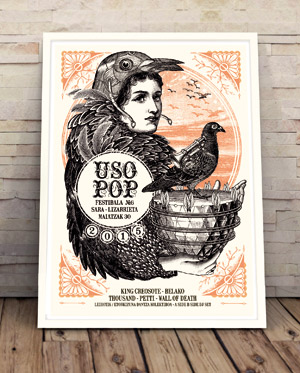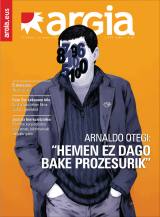Putting images into the sound
- He has always been accompanied by the visual arts, especially through posters and covers. In our environment, the relationship also has a long tradition. After the punk movement of the 1980s, the thread has not been interrupted; it has diversified and enriched in these digital times. We've talked to artists Fortun, Arrate Rodríguez and Ramón Zabalegi and the musician Ander Mujika, and they're clear: people do it and it's OK.

That has always been the case. Among other things, when musicians and artists ask you why they want musical groups to have a special poster to announce their performances and why so many artists link to that work. In addition, Mujika says: “To encourage people to concerts, a poster is more attractive than a list, it’s a kind of revulsive, I would say it’s a representation of what a concert is going to be. It continues to be done by hobby, by passion, but then, perhaps, only via the internet, because the spectator likes to have a visual reference of the concert, and also the organizers”. And Fortun: “I wouldn’t understand the music without a poster or a good cover; after all, nobody wants to take a good record with a bad skin, everything goes together.” Rodríguez has focused on the practical role of cartels: “I drew and wanted to apply it somewhere; I started making posters quite unconsciously, because I had the need to leave the site where the drawings were, to do something with them, something more than put them in an exhibition.”
Initiation between friends
The fact that art and music are as close as cause or consequence, musicians and artists end up being friends. Zabalegi started making posters for the drumming groups in Fortún, was encouraged by what he needed Irun's gaztetxe, and in recent years he has worked with the covers of those around him. Rodriguez created the first poster for Napoka Iria's friends.
According to Mujika, collaboration is also impressive from the point of view of musicians: “It’s a gift to be able to announce a concert with a sign made by a friend; if we went to design agencies to ask for this kind of thing, it would be much more industrial. In addition, the colloquial movement is also enriching from the point of view of style, as a lot changes. We like each designer to work according to their own judgement, so we have a wide aesthetic range instead of following a single line. One does it with a picture, another with watercolor... it's nice to have that record." According to Rodríguez, it is the support itself that gives the way to diversity: “Because it’s a poster, you can choose a moment or an image that gives you that music, because you know there is only one poster and there will be more: you choose that moment and another takes something else; in the case of the albums, you have to gather all the songs in one image, and the musicians also give them more reticence.”
The more it's known as a cartelist, the more other orders come. Fortun: “I’ve made posters or records many times for groups I don’t like, and I think in these cases it’s also to be thankful, I’m grateful for having such a job and I put the same forces in both. Each poster also serves to learn and improve.” Zabalegi: “So far I’ve worked with people that I feel very close, but lately I wonder if this is a job for me, because I’ve started calling from other places, to order orders, and it’s different from what I’ve done with previous ones. I'll set limits, but I don't know where."
To start working, music as a hub
Asked about the creative process, they all start from the music. Rodríguez: “I usually put music on, it’s pretty amazing and it makes us all think of something. That reminds me is usually not very literal, I get a smell of environment and it reminds me I don't know in which film I've seen something; so I make hyper-large conceptual maps and one thing leads me to another. When I decide what I mean, I take the models and then I get distracted from the music and start working on my images.”
Fortun: “I must meet the first team, if I don’t know it before. I put your music, if it's a skin that's the disk itself and, if not, your last job. I also read letters, then I prepare a sketch for each letter, and mixing all that I make a drawing. For who the image is, I take one technique or another. It is very important to know the different techniques, as it is not the same to make a poster for a rock group as for a hardcore group, or for Ruper Ordorika. If I lack inspiration, I see films or documentaries, looking for ideas, or I give a few spins on Pinterest, to look at the works of other cartoonists.”
Zabalegi says that if you know the musicians or are friends, think about them, see what they suggest. “On the other hand, on many occasions, musicians relate the album to their vital time, so I also work accordingly. For example, Ainara Legardón told me that his last album was a bit hard, because he had experienced many changes, but at the same time he grasped those changes hard and that the album was also strong.”
As many styles as cartelists
At first, Zabalegi performed his work digitally. But now he prefers what he did by hand: “In the 1990s, Photoshop and other programs started coming in, and people started doing it all by computer. Digital has advantages, of course, but I think that by using the same tools, very homogeneous images have been created. I was doing it all by computer at first, but then I started drawing and now I'm trying to do almost the whole process by hand, until the time of the scan. For example, I'm now working with wood to create a matrix and make a xylography. The process itself is much richer, because it's not just visual: you touch wood, you smell ink... On the other hand, there is a component of error. Putting an error on your computer is very difficult, but when you do it by hand you always have it there and sometimes the answer starts with the error. In life itself, I don't like things too much regulated, and in drawings, I try to escape that supposed perfection. I try to reflect other values, even through a very small and perhaps invisible rebellion.”
Combining styles, Fortún has recently sought its own aesthetic: “I use two or three styles: vector, very colorful drawings with computer; collages made with old drawings, which then give color; and illustration: I make hand drawings and then give them color. These three styles look a lot, and now I look for my characteristic style; I know I'll need a lot of time, but I'm in it. On that road, I'm mixing the illustration and the collages of old drawings. On the other hand, when it comes to making the composition, it is quickly seen that I was delinquent, and it is also seen in the drawings, I make animals or mechanical people, with the screws, etc.”
You know, Rodríguez has drawn many faces: “Through portraits you can tell a lot of things. In addition, musicians are people, and also the ones who listen to music: people are the ones who explain the most. I'm interested in imperfection, because what's not imperfect is industrial. On the other hand, as a spectator, we are all very used to seeing stereotyped portraits, with lips like this and so, if the teeth do not appear better... That's very artificial, and it doesn't represent me."
Your criminal record has ended for the album, through the Savanna Studio, composed by Rodríguez and Carlos Ndungmandum: “After so many years with portraits, I’ve gone into a new phase, because when you are continuously with one thing, you lose others. Anyway, I did a portrait with Anari's record, because it seemed like a psychological job to me, and it had to be consistent with what the record was asking for. I very much liked the interpretations that people have made, many of them, about the person of the skin, which readings have been different to him. It’s beautiful when drawing makes its journey, it’s the best thing that can happen after finishing a job.”
Lack of knowledge to the detriment of the good quarry
According to Rodríguez, over the last fifteen years things have improved from the point of view of recognition of work: “The first illustrators and designers were never named. Today we have again talked about who has done it, and we have a little respect for that work.” But we need to broaden our knowledge, that's what Fortun says: “There are very good people in Euskal Herria, but they are not well known, at least for those who should be. However, having a network between us is very important: maybe you've been with a poster for 30 hours, blocked, and you can always ask a friend for help. There is no envy among us, on the contrary, we are all making strength for all of this to be more recognized.”














